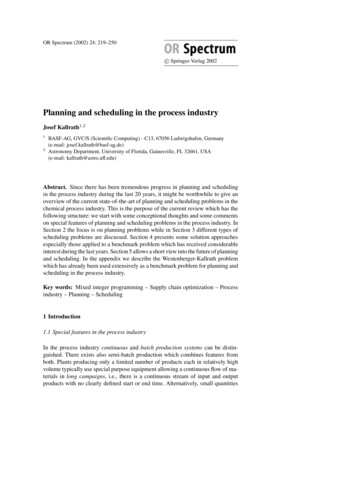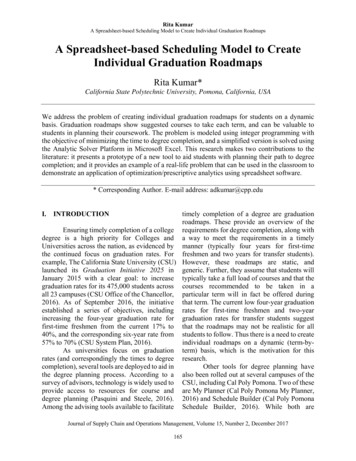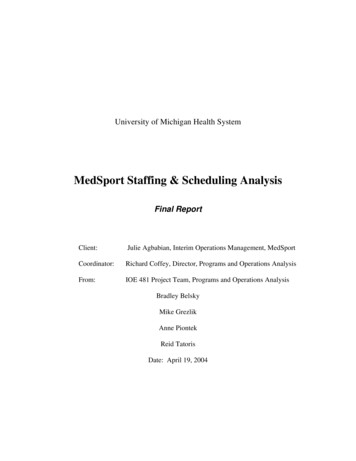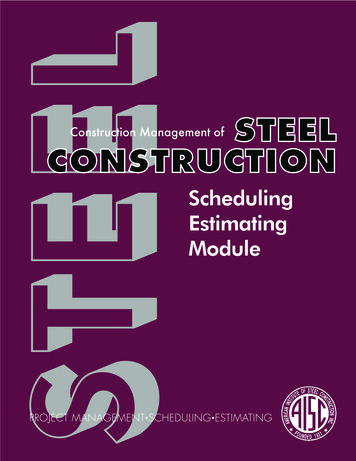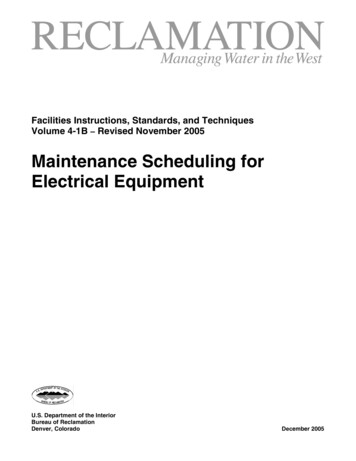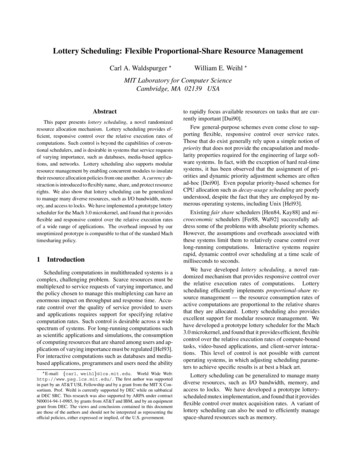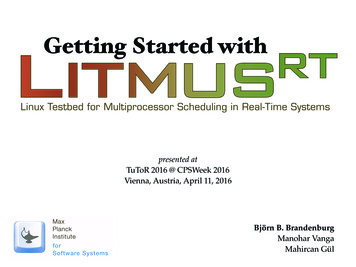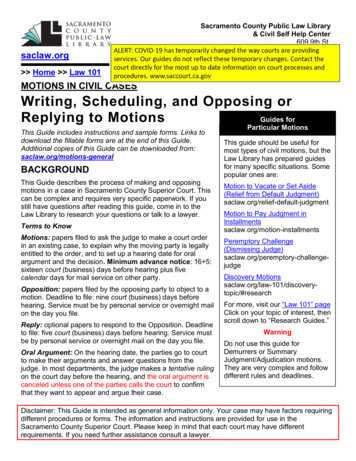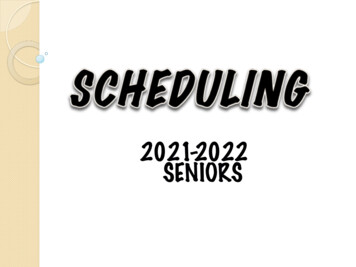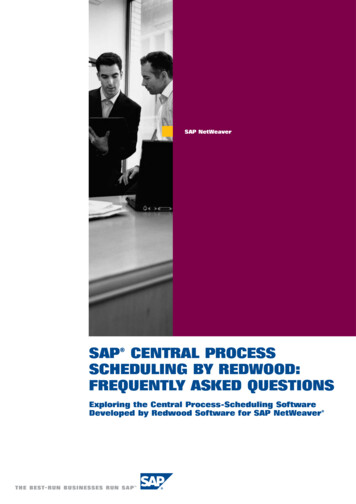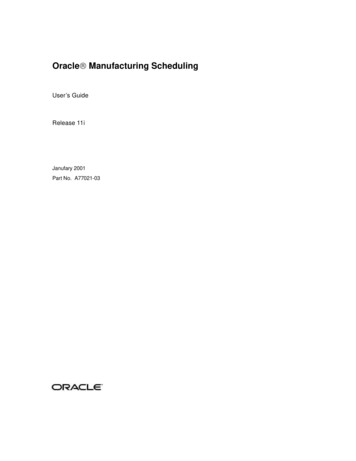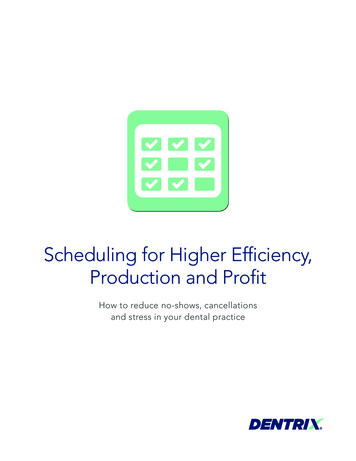
Transcription
Scheduling for Higher Efficiency,Production and ProfitHow to reduce no-shows, cancellationsand stress in your dental practice
About the AuthorCathy Jameson is the founder of Jameson Management, an international dentalmanagement, marketing and hygiene coaching firm. The Jameson Method ofManagement, developed by Cathy, offers proven management and marketingsystems for helping organizations improve their workflow and efficiency in apositive, forward thinking culture. Cathy earned a bachelor’s degree in educationfrom the University of Nebraska at Omaha and then a master’s degree inpsychology from Goddard College. She received her doctorate from WaldenUniversity. She considers herself a lifelong learner and encourages those aroundher to be in a constant state of study, growth and action. She is the author ofseveral books, including her latest title "Creating a Healthy Work Environment."For more information on Jameson Management's services, visit their website atjamesonmanagement.com.
Table of ContentsDiagnosing a Broken ScheduleIs This Happening in Your Practice?.4Preventing Schedule ProblemsHow Each Team Member Can Help.5Building a Balanced ScheduleHow to Avoid Production Highs and Lows.6Sell the Value of Every AppointmentGreat Communication Great Production.8Coping With a Broken ScheduleLeverage Your Dental Software.9
Diagnosing a Broken ScheduleIs This Happening in Your Practice?Poor scheduling can be a major source of stress inyour dental practice. If your appointment book is fullbut office tension is high, your scheduling processmay be broken.Ask yourself: Are cancelled appointments and no-shows anepidemic in your practice? Does your office consistently run behind schedule? Are you rushing one appointment so you can geton to the next? Does it take weeks before you can fit a newpatient into your schedule? Does your schedule allow you to perform thekind of dentistry you want to do? Are schedule holes causing excessive stress onyou and your team? Is your schedule so overbooked that you don’teven have time to eat? Is your schedule burning you out?If you answered “yes” to at least three ofthe above questions, your schedulingprocess needs repair.This eBook can help you prevent scheduling problemsand build a more productive and profitable schedule.Done properly, scheduling can reduce no-shows,cancellations and stress in your dental practice.When you have more organized, smoother days, yourpatients will receive more concentrated, quality attentionfrom you. Your improved concentration and lowered stresswill be of ultimate benefit to your patients and to you.Plus, you’ll get to practice the kind of dentistry you desire.Ten ScheduleStresses andTheir Solutions1. Late patients. If you run late,you're training patients to be late.2. Improper scheduling of timeunits. Analyze how long eachprocedure takes.3. Poor software or lack oftraining. Schedule in 10-minuteunits for each active chair.4. Emergencies. As much aspossible, provide palliativecare and reschedule.5. Doctors scheduled in tworooms at once. Assign whenand where the dentist shouldbe with no overlaps.6. Improper delegation. Delegateto your clinical assistant asmuch as your state allows.7. No detail in the schedule.Include procedure specifics forproper room and tray setup.8. Poor communication. Keepyour team well informed.9. Personal phones. Minimize cellphone use during work hours.10. Talking about non-dentalissues. Be friendly but focuson the business at ers/CJ CausesOfSchedulingStress.php4 SCHEDULING FOR HIGHER EFFICIENCY, PRODUCTION AND PROFIT
Preventing Schedule ProblemsHow Each Team Member Can HelpPreventing broken appointments, no-shows andother schedule problems isn’t just the appointmentcoordinator’s job, it’s everyone’s job.Here are six ways your team can help:1. Give patients a reason to come back. At theend of every appointment, the clinical teammember who is with the patient should stress thesignificance of the next appointment. Discuss thebenefits of the next appointment and the possiblerisks of not showing up.2. Learn the verbal skills of scheduling. Theappointment coordinator should indicate theamount of time being blocked for the patient inthe doctor's schedule. Help the patient acceptresponsibility by saying something like, “Thedoctor has reserved this time for you and we’rerelying on you to be there.”3. Confirm appointments. Confirm in a positivemanner and always stress the importance of theappointment and the patient's responsibility forthe appointment.4. Change your after-hours voicemail greeting.Some patients will call at night and leave arecorded cancellation message. Discourage this bychanging your greeting to reflect the preference thatthey call during business hours.5. Reschedule immediately. If a patient calls aboutchanging an appointment, reschedule them whilethey are on the phone.Team GuidelinesFollowing these simple guidelinescan help keep your schedule on track: Make it a practice rule: No oneleaves the office without ascheduled appointment. Understand the amount of timeneeded for each procedure andeach appointment. Train everyone who touches theappointment book how to usethe scheduling software. Acknowledge delays to patientswho are waiting and thank themfor their patience. Ask patients about their nextappointment and help themunderstand its value. Address clinical or financialconcerns in a private area—notat the checkout counter—beforepatients leave your office. For best results, scheduleappointments face-to-face. Build relationships with yourpatients to give them morereasons to come back.6. Bring it up in morning meetings. During yourdaily team briefing, discuss how to fill any voidsin the hygienist’s or doctor’s schedule. Enlist teammembers to audit charts and look for patients whocould possibly fill the open time slots, such as thosewith past-due treatments, unappointed restorativework or unappointed family members.SCHEDULING FOR HIGHER EFFICIENCY, PRODUCTION AND PROFIT 5
Building a Balanced ScheduleHow to Avoid Production Highs and LowsBuilding a balanced schedule—with the right mix of primary,secondary and tertiary procedures—allows your practice toavoid highs and lows in production. (See Figure 1 on p.7) Primary procedures have a higher dollar valueattached to them, such as crown and bridge,endodontics, dentures and partials and mostcosmetic procedures. Secondary procedures have a lower dollar value,such as simple composites and extractions. Tertiary procedures have no dollar value attached,such as seating of crowns and bridges, sutureremovals, etc.The secret to getting the right mix of procedures intoyour schedule is pre-blocking: reserving specific timeslots each day for primary procedures. Pre-block yourdays for approximately half of your production goal.Then add secondary and tertiary procedures aroundyour primaries as needed.The key to productivity is not how manypatients you see in a day, but how muchdentistry you do in a day.Schedule a variety of procedures each day to meet aspecific, daily production goal, rather than aim for acertain number of patients per day. This smooths out thehighs and lows, increases your productivity and reducesfinancial and physical stress for you and your team.As a result, your patients will appreciate you more.For example, let’s say your monthly production goal is 70,000 and you work 16 days per month. Divide 70,000by 16 to find your daily production goal of 4,375 perday. Break this down to to 3,000 for the doctor andclinical team and 1,375 for the hygiene department.6SchedulingEssentials1. Schedule toward a predetermined goal – yearly,monthly and daily.2. Include a variety of proceduresin your day – primary, secondaryand tertiary.3. Pre-block approximately halfof your daily goal in primaryprocedures.4. Delegate. as much as possibleso the doctor can focus on doingwhat only a doctor can do.5. Analyze how long a proceduretakes for both doctor andassistant and scheduleenough time.6. Provide hygiene evaluations ata natural break in the doctor’sschedule rather than at the endof a hygiene appointment.7. Always make financialarrangements prior toscheduling an appointment.8. Schedule fewer patients in aday, do more dentistry whenand where appropriate andsee patients for fewer visits.Source:jamesonmanagement.com SCHEDULING FOR HIGHER EFFICIENCY, PRODUCTION AND PROFIT
Building a Balanced ScheduleHow to Avoid Production Highs and LowsFigure 1: Example of a balanced schedule with a mix of proceduresSCHEDULING FOR HIGHER EFFICIENCY, PRODUCTION AND PROFIT 7
Sell the Value of Every AppointmentGreat Communication Great ProductionDental appointments deal with people’s money andtime, two of the most important things in their lives.People break appointments if they don’t understandtheir importance—or value—compared to everythingelse going on in their busy lives.Part of fixing scheduling problems includes improvingtreatment recommendations. If your patient is onlyinterested in how much their insurance will cover a giventreatment, you’ve failed to sell the value of your services.The following strategies help you communicate valuewhen presenting recommended treatment: Empower your hygienists. Hygiene appointmentsare the most frequently broken type ofappointments. Patients may not feel the need tocome in if they’re not experiencing any problems.Because 40 to 60 percent of the dentist’s productioncomes directly from hygiene, it’s critical to empowerhygienists as patient educators. Give them the time,equipment and technology to help patients see thevalue and benefits of treatment. Use visual aids. Videos, photos and X-rays helpshow patients “this is what’s going on in yourmouth.” Show before and after pictures to illustratetreatment benefits (or risks of skipping treatment). Discuss total wellness. Explain how your treatmentwill help patients with their health, appearance,breath, snoring or other wellness issues. Listen. Answer patients’ questions and hear outtheir concerns. Slow down and pay a little bit moreattention to people and what brought them to youin the first place. This builds a relationship of trustthat will solidify their commitment to attendingappointments.Four Factors ofBuyer AcceptancePoor communication is theunderlying reason for mostappointment cancellations.Until your patients truly understandthe value and benefits of treatment,they may schedule an appointmentonly to cancel it later.In today’s competitive dentalmarket, patients won’t “buy” whatthey don’t understand.You and your team can preventcancellations by focusing on thesecritical factors of buyer acceptance:1. Need for the visit2. Value of the treatment3. Urgency of the procedure4. Trust in the providerCommunicate these fourfactors before you schedule anappointment and your patient ismore likely to keep it.Buying decisions are based onpeople seeing value. Be sure toschedule enough time to presentyour treatment plans, explaintheir value and clear the way foracceptance. Find financial solutions. Work with your patientsto find payment options so they can overcome anyfinancial barriers to treatment. If patients aren’t clearand comfortable with the financial arrangements,they'll cancel or no-show.8 SCHEDULING FOR HIGHER EFFICIENCY, PRODUCTION AND PROFIT
Coping With a Broken ScheduleLeverage Your Dental SoftwareEven if you follow the best scheduling practices,someday your schedule will fall apart.No-shows are the worst. Call any patient that is fiveminutes late. If they answer, express concern: “We havethis time reserved for you, are you OK?” See if they cancome in for a partial appointment and at least get themrescheduled. Put the patient data in the tickler file if youare unable to reach them.Remember, today’s lost production is lost forever. It’smore important to focus on filling today’s schedule thanfour weeks out. To fill last-minute openings, look at yourappointment book: Is there someone from restorative you can move tohygiene, or vice versa? Is there someone in the afternoon you can moveto morning? Is there someone scheduled tomorrow or later thisweek you can move to today?Your dental software can help you keep current lists ofpatients you can call to fill unexpected schedule voids.Ask a Professional for HelpDental practice consultant Cathy Jameson understandsthat scheduling is the lifeblood of your practice. She hashelped thousands of dentists worldwide become moreproductive with her proven management strategies.Contact her at jamesonmanagement.com.Rely on the Industry LeaderDentrix provides software solutions for greaterproductivity and profitability in your practice. That’s whymore than 35,000 dental practices rely on Dentrix today.Dentrix ToolsHenry Schein's Dentrix includesthese scheduling tools: Perfect Day Scheduling forpre-blocking appointments tomeet your production goals. ASAP List for patients who wantto get in sooner than originallyscheduled. Continuing Care List forunscheduled patients who areoverdue for hygiene. Treatment Manager Reportfor finding patients who need acertain procedure so you can filla specific time slot. Treatment Plans with BenefitsAvailable Report for patients whohave treatment plans posted tothe Ledger and unused insurancebenefits available. Unscheduled List for patientswho have either broken anappointment or asked to beon will-call. Automated Reminders forupcoming appointments thatallow patients to confirm by textmessage or email.Visit Dentrix.com for details.In addition to full-featured clinical tools, Dentrixincludes financial analytics, accounting and billing tools,innovative eServices, training seminars, profitabilitycoaching and more.SCHEDULING FOR HIGHER EFFICIENCY, PRODUCTION AND PROFIT 9
Notes
2016 Henry Schein Inc. EBK-DTX-SCHED-Q216
Videos, photos and X-rays help show patients “this is what’s going on in your mouth.” Show before and after pictures to illustrate treatment benefits (or risks of skipping treatment). Discuss total wellness. Explain how your treatment will help patients with their health, appear

